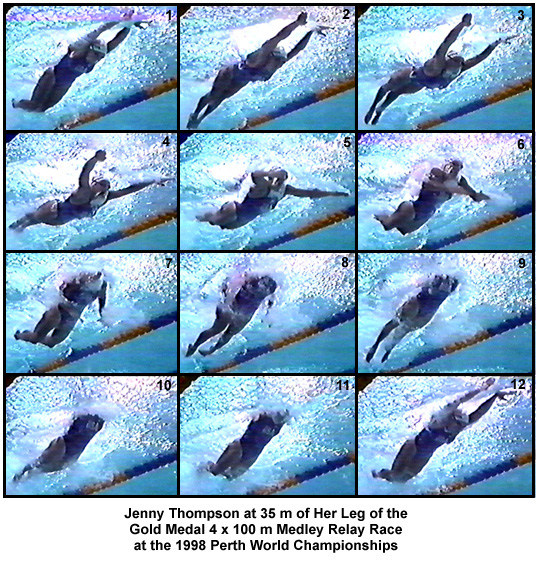HOW CHAMPIONS DO IT
Researched, produced, and prepared by Brent S. Rushall,
Ph.D., R.Psy.

JENNY THOMPSON (BREATHING STROKE) AT 35 m OF HER LEG OF THE GOLD MEDAL 4 x 100 m MEDLEY RELAY RACE AT THE 1998 PERTH WORLD CHAMPIONSHIPS
Each frame is .1 second apart.
Notable Features
- Frame #1: The hands enter close together and turned outward. The body is streamlined. The kick is half completed in its role of counter-balancing the vertical forces created by the entering hands.
- Frame #2: The hands are pushed apart with a pitch angle that develops vertical lift forces to slow the descent of the head and shoulders. The kick is almost completed. Since the arm movements act upon the vertical movement of the head and shoulders the hips begin to rise as a consequence of the kick. The head starts to look forward.
- Frame #3: The completed kick has forced the hips to break the water surface. That effect is unnecessary and causes considerable energy to be dissipated into the water through wave resistance. The arms have been repositioned to where direct propulsive forces can be initiated. The head looks further forward, which along with the elevated hips causes a "hollow" back. This is not a streamlined position. Increased turbulence off the nose is visible.
- Frame #4: Propulsive forces from the hands and arms begin to be developed. The hands have spread wider at the same time as the occurrence of adduction of the upper arms and flexion at the elbows. Evidence of drag force production can be seen through the trailing turbulence following from behind the left hand. As the legs rise to a position where another kick can be performed, the hips drop in a counter-balancing action.
- Frame #5: Vigorous adduction of the arms and further bending of the elbows produces hand/forearm propulsive surfaces that create backward and downward force components. The downward component is used to elevate the head and shoulders. The head has broken the surface preparatory to breathing. The feet are high and the knees begin to bend in preparation for a kick.
- Frame #6: As adduction continues but nears the end of its effectiveness, the hands sweep in due to the late stage of adduction and increased elbow flexion. That positions the arms for extension. The knees continue to bend preparatory to kicking and the shoulders approach breaking the surface.
- Frame #7: Very rapid extensions of the elbows with the hands maintaining a vertical orientation produce a strong backward force. The kick has started so that it will be timed with the impending vertical extraction of the arms. The shoulders and head are clear of the water.
- Frame #8: Arm extraction has begun with the elbows breaking the surface. However, hand propulsion has been maintained as evidenced by their trailing turbulence. The kick continues. Inhalation usually begins at this stage.
- Frame #9: The arms have exited and the kick is almost completed. The thighs, hips, and torso are relatively flat given the constraints of performing an over-the-water recovery.
- Frames #10 and #11: During the recovery and kick preparation the swimmer remains reasonably streamlined. The positioning of the feet through knee bend (#11) with no hip flexion is a good feature.
- Frame #12: The position in frame #1 is repeated.
Jenny Thompson's butterfly stroke contains good features. Improvements could come from a wider entry, which would result in less inertial lag before direct propulsion was developed. That entry would also reduce her moderate "diving." Both features would result in faster swimming and a technique that would be well suited to both 100-m and 200-m events.

Return to Table of Contents for this section.




